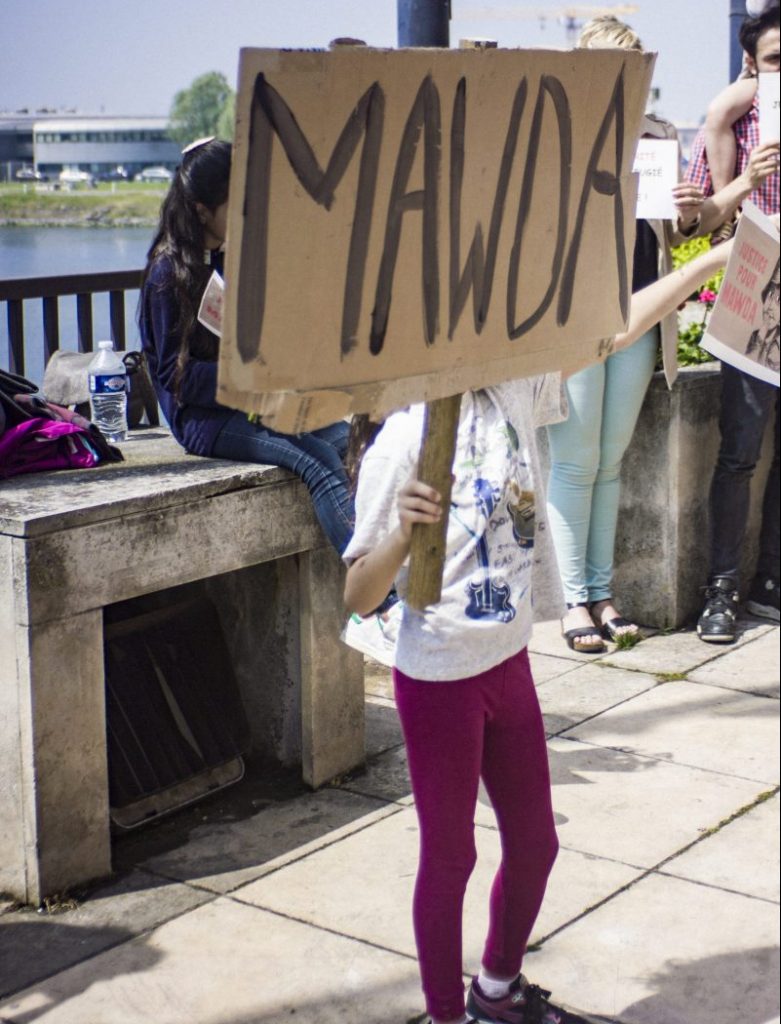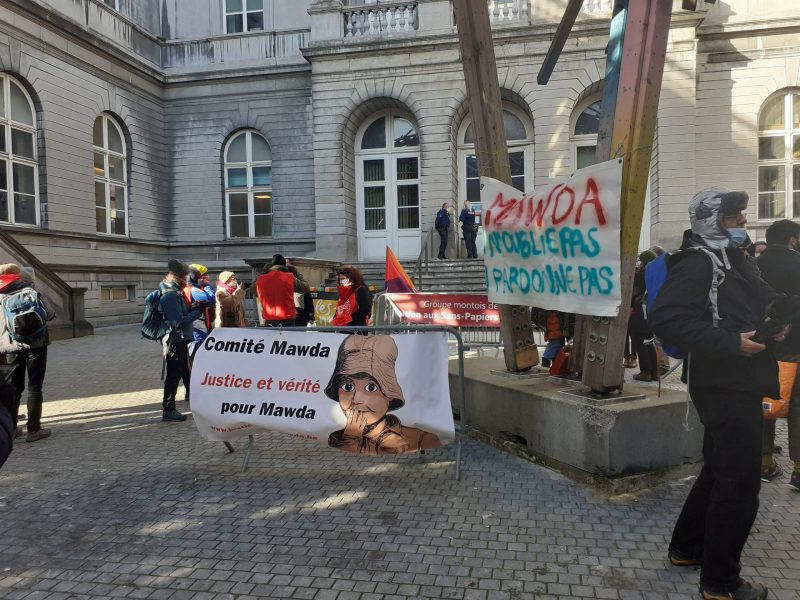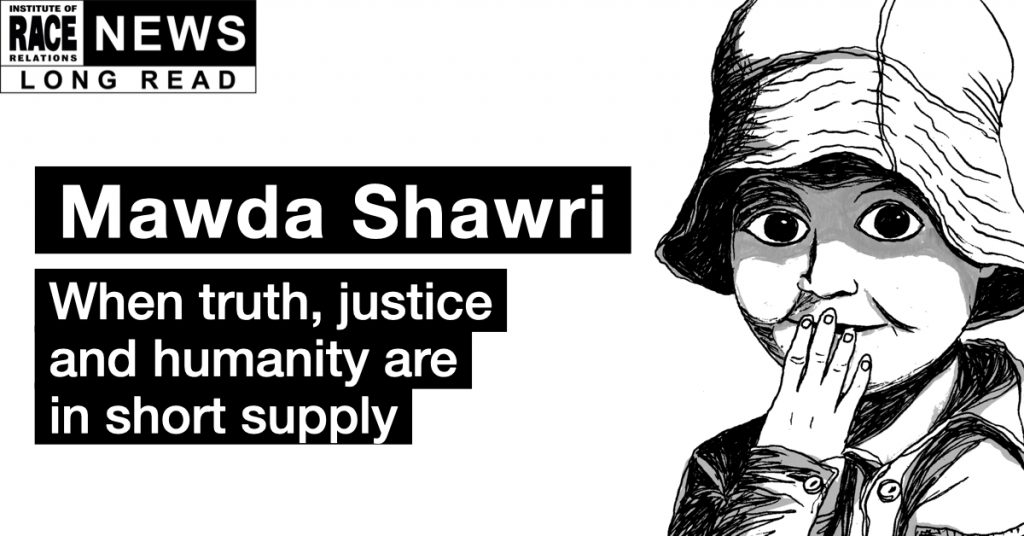At the conclusion of the trial of the Belgian police officer who shot and killed two-year-old Kurdish Iraqi Mawda Shawri, a case that has become a symbol of the violence and injustice faced by those crossing borders within Europe to seek a better life, a campaigner Frances Timberlake reflects on a flawed process and provides a timely reminder that the UK is deeply implicated in European border policing.
On Friday 12 February, the criminal court in Mons, Belgium, delivered its verdict on the death of Mawda Shawri, a two-year-old Kurdish Iraqi girl killed by a policeman’s bullet in May 2018. The two and a half years of investigations that followed her death have been marked by internal contradictions in the versions of events testified by the police, as well as between those versions and what witnesses including Mawda’s parents have consistently said. Along the way, Mawda’s family and other migrants that were travelling with them in the hope of reaching the UK have been blamed for the death of the young girl, an interpretation which culminated last week in a four-year prison sentence for a young Kurdish man accused of driving the van that was shot at with Mawda inside. The court meanwhile concluded that the policeman’s act in shooting her constituted ‘involuntary manslaughter’ and gave him a twelve-month suspended sentence, continuing a trend of denying or minimising responsibility for police violence in the context of anti-migrant border operations. This article recounts the treatment of Mawda’s family following her death and the intricate web of contradictory stories that were released by public authorities and later used to argue the innocence of the policeman who fired the shot. Beyond the trial, which avoided positioning itself on the border and immigration policies that generated this story, the UK’s financial and political role in generating this violence at its borders with the intention of deterring immigration onto its own soil must not go unscrutinised.

How Mawda died and how her death was framed
On the night of 16-17 May 2018, Mawda, a two-year-old girl who was sitting in her mother’s arms, was killed by a bullet from a policeman’s gun during a car chase near Mons on the France-Belgium border. The bullet, apparently aimed at the wheel of a van carrying around thirty migrants, was fired through the window and hit her cheek. From that moment, a series of painfully dehumanising measures were inflicted on the family even as extraordinary attempts were made to control the official narrative about the chain of events that led to Mawda’s death – so as to deflect blame from the police operation that preceded it.
Mawda’s family, along with several others, had been travelling in the back of a small van driving them to a lorry park where they were to hide aboard a freight truck, hoping to be able to reach the UK to claim asylum. They were one group of many who attempt this journey nightly, at that time mostly passing through Dunkirk where for the last ten years there has been a small population of mainly Kurdish Iraqi and Kurdish Iranian migrants living in informal tented camps, waiting for a chance to reach the UK.
The police claimed that the officer had fired at the wheels of the van in order to bring the van to a halt. As the terrified migrants on board came out of the van, the police surrounded them, and according to Mawda’s father, the child was taken from his arms and he was hit multiple times by the police. When an ambulance was finally called, both parents were forcibly prevented from accompanying Mawda; instead they were arrested and taken to an immigration detention centre where they were held separately. It was only two days later that they were allowed to see Mawda’s body.
In the immediate aftermath of the death, and in the days that followed, a series of statements were made both by a police spokesperson and the Mons public prosecutor’s office that contradicted Mawda’s parents’ testimony that their daughter had been killed by a shot through the head.
- At 2.15 am on 17 May, paramedics arrived on the scene ten minutes after the van was immobilised. Police agents present declared to the paramedics that there had been no gunshot during the chase and that the young girl had fallen from the window of the van, despite there being no witnesses to any fall. This was immediately supported by the Mons crown prosecutor, who claimed that the forensic doctor who arrived at the scene ‘ruled out the possibility of a shot to the head’ – a statement the doctor would later deny.
- At 3 am, a police officer informed the officer charged with writing up the account of the incident that there had in fact been a police shot fired during the chase, and another potentially from people inside the van. Despite this, the public prosecutor continued to ‘exclude the possibility of a wound caused by a shot from a policeman’ at the press conference on 17 May. Although there were no witnesses to a second shot, and no firearms found in the van or on any of the migrants, the public prosecutor’s office still entertained the ‘second shot’ theory in a press conference on 18 May. This was quickly picked up by the media and used to form a story around Mawda being caught in crossfire between migrants and police.
- In parallel, a narrative of Mawda being used as a ‘human shield’ was introduced, and is still cited now. The officer writing the account immediately following the incident wrote an initial version as follows: ‘During the chase (…) they break the windows with the head of a child and they pretend to throw it out towards the police cars. The blows the child received result in a head injury and the death of the child.’ In this version, the migrants killed their own child by using her head as a battering ram. Interestingly, when the policeman who fired the shot was finally charged with involuntary homicide, his legal team presented as his defence the argument that he did not know there were any children in the van. There were in fact four young children in the van.

The family fights on
Looking back now, almost three years later, one would be entitled to regard the above as shameless fabrications, placed strategically in the media domain in the hope that if flawed assertions are repeated often enough they will come to be regarded as incontrovertible facts. Indeed, the official narrative did come to serve this purpose, with the confusion of the facts replicated not just in the media but in the course of the legal investigation.
It was a narrative that served also to cast doubt on and discredit the family, their own testimony and those of other migrant witnesses who had been in the van that night. The blame that was immediately placed on the family for the death of their own daughter built on a well-established caricature of the reckless ‘illegal migrant’. A large part of the media were happy to peddle this trope. By so doing, they legitimised the authorities’ treatment of Mawda’s parents and her then three-year-old brother as undesirable and disposable, both in the immediate aftermath of the killing, and in the days and months that followed. When the family was finally released from detention, they were issued with an order to leave Belgian territory, a decision all the more gruelling in that they had not even the right to bury their own child as Mawda’s body was still being held in the country for investigation. But the family, now supported by the Comité Justice et Vérité pour Mawda, bravely fought on. After a long legal battle, in February 2019 they were granted temporary visas to remain in Belgium. In January 2020, the police officer was charged with involuntary homicide, a charge contested by the family and campaigners who maintained that it should be increased to reflect a deliberate killing. The family’s lawyer argued that ‘to take out his weapon, load it and fire it towards a van full of migrants represents more than just a lack of due care and should not be minimised’.
In the courtroom – the bias continues
Two and a half years later, on the 23 November 2020, the trial to establish responsibility for the killing of Mawda finally began.
The Belgian criminal justice system differs from the UK system in that it follows an inquisitorial, rather than an adversarial approach. Under an inquisitorial system the public prosecutor plays an important role in the courtroom. This gives context to a situation where the public prosecutor who carried out the initial investigation into Mawda’s death, and as we have seen, introduced flawed facts into the public domain, sat alongside the judge, both tasked with establishing culpability. It also explains why campaigners had called for the prosecutor’s office itself to be investigated, arguing that this very institution should have sat amongst the accused at the trial.
And who were the accused? First there was the Belgian police officer, charged with involuntary manslaughter, with the prosecutor seeking a one-year suspended sentence. But there were also others. He was arraigned alongside two Kurdish men, the alleged van driver and smuggler, for whom the crown prosecutor sought sentences of ten and seven years respectively for ‘dangerous driving endangering the lives of others’.[1] However, lawyers contested the assertion that either of these two men had even been present that night as indeed none of the witness testimonies identify the man accused of driving the van.

Once again, one would be forgiven for thinking that the accusations, and court proceedings, were emblematic of a wider (in)justice system designed to uphold the impunity of the state and deny responsibility for systemic racism. The court afforded the White policeman a generous amount of time to plead his own innocence, with his own pleadings heavily relying on the fact that he was the grandson of immigrants and therefore would never have intentionally shot at a migrant. In contrast, the two Kurdish migrants were cut short when they attempted to explain their own stories, with the judge deeming them ‘irrelevant’ to the case. The arguments against both migrant men relied almost entirely on the depiction of them as illegal migrants involved in criminal cross-border trade, even though their involvement in smuggling had not yet been established.
In the final verdict, the alleged smuggler was acquitted for lack of evidence that he had played any role in the affair, as only a single witness statement had identified him as someone present that night. The alleged driver meanwhile was sentenced for dangerous driving provoking an accident, based on police testimonies (unsupported by witnesses inside the van) that he had zigzagged in the road, and swerved towards the police vehicle at the moment the accused policeman was holding out his gun to frighten the driver into slowing down. It was at this moment that the policeman fired the shot, judged to be the involuntary result of the van swerving. Mawda’s father, however, who was in the van with her, testified that ‘I saw the policeman point his gun. He did not hesitate in drawing it. I saw him shoot and the bullet hit my daughter.’ Although the Mons judge ruled that the officer should not have used his firearm as there were other ways of stopping the van, the ‘dangerous’ migrant driver bears the weight of responsibility for Mawda’s death, with his behaviour seemingly used to excuse the Belgian policeman’s shot – as though the brutality displayed was mistaken deviance from technical rules, rather than a product of policies intended to deter and harm migrants. This division of criminal responsibility was reflected in the sentences: four years for the driver; one year suspended and a EUR 400 fine for the officer whose shot killed the child.
Border violence: what is the UK’s role?
Border zones lie at the heart of policies that harm and kill. The police operation that resulted in Mawda’s death was one of many that take place at the UK-France-Belgium border, the coordinated attempts by these three countries to intercept and dissuade migrants attempting to board lorries or boats to travel to the UK. In the past, migrants have attempted the crossing via the northern French ports of Dunkirk and Calais, but as port security was heightened under UK pressure (and funding), they were increasingly forced to travel via Belgium. The Belgian government responded particularly forcefully to this by launching the euphemistically named Operation Médusa, the disturbing facts of which only came into the public realm after Mawda’s death thanks to independent journalistic investigations. We now know that the van in which Mawda and her family were travelling was being tracked by both French and Belgian authorities as part of this operation. This meant a car chase was likely, if not expected.
The UK, which is behind much of the crackdown on those attempting to reach its territory, has much to answer for in this border region. Over the last thirty years successive UK governments have externalised the UK’s physical border controls and detention estate into France and Belgium, simultaneously extending insidious forms of financial and political influence without any corresponding legal or moral accountability. The model of immigration deterrence along the northern French border region based on securitisation, surveillance and policing is a direct exportation of the UK’s own ‘Hostile Environment’ abroad, at an estimated cost of £360 million since 2010. Campaigns to increase prosecutions of ‘traffickers’ or ‘criminal facilitators’ serve to brand all those forced to cross borders irregularly as dangerous, whilst in reality rendering the crossing of borders even more dangerous by pushing it so far outside of the law.
Indeed, since the increased crackdown against migrants travelling by freight vehicles on the southern Belgian border, and heightened security at the large ports in Calais and Dunkirk funded and implemented by the UK government, we have seen a rise in attempted small boat crossings. Further tragic, and yet not unpredictable, deaths have taken place as a result, including that of an entire family in October 2020 who drowned during a particularly rough boat crossing. Once again, blame was afterwards placed on the ‘callous criminals’ (the words of British home secretary Priti Patel) who facilitated the journey rather than the anti-immigration policies that push people into their business model.
Recently, the UK committed to beefing up French border policing through £28 million of government payments, despite documented harassment and life-threatening negligence on the part of French police in the northern coastal area. Once again, policing is promoted as the solution to a set of issues that are perpetuated by the political and judicial systems that police themselves uphold. Just as Mawda’s trial has been co-opted by those adjudicating it in order to reinforce the need for immigration and border policing, rather than examine its deadly effects.
What is at stake in the Mawda case is twofold. At one level, a grief-stricken family is denied not only justice after the death of their daughter, but also any belief that the system they are caught up in can ever treat them with humanity and dignity, given that they are only ever seen as ‘illegal migrants’. On another level, the final verdict has only served to condone years of lethal immigration operations against those attempting to seek asylum in the UK, or in any country other than the one they are currently in. It has exposed the measures that states, bolstered by deep-seated political and legislative racism, are prepared to take to keep them out of sight and out of mind.
Related Links
To add your voice to the call for a parliamentary Inquiry in Belgium into Mawda’s death, sign the petition here.
To follow updates on the case, follow Justice for Mawda.
Frances Timberlake has been working with displaced communities on the northern French coastline since 2016, formerly as a caseworker with the Refugee Women’s Centre and currently as a policy campaigner with Refugee Rights Europe. At the time of Mawda’s death and since, Frances has worked closely with Mawda’s family, and participates in the Comité Justice et Vérité pour Mawda.


Terura morto kaj neniu kulpigas la verajn kulpantojn, la registarojn de Usono kaj aliancnaoj, kiuj portis militon en la meza oriento.